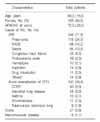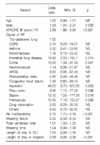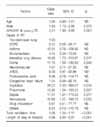Abstract
Background
Respiratory failure is a common condition that requires intensive care, and has a high mortality rate despite the recent improvements in respiratory care. Previous reports of patients with respiratory failure focused on the specific disease or included a large proportion of surgical patients. This study evaluated the clinical characteristics, outcomes and prognostic factors of adult patients receiving mechanical ventilation in a medical intensive care unit.
Methods
Retrospective chart review was performed on 479 adult patients, who received mechanical ventilation for more than 48 hours in the medical ICU of one tertiary referral hospital.
Results
The mean age of the patients was 60.3±15.6 years and 34.0% were female. The initial mean APACHE III score was 72.3±25. The cause of MV included acute respiratory failure (71.8%), acute exacerbation of chronic pulmonary disease (20.9%), coma (5.6%), and neuromuscular disorders (1.7%). Pressure controlled ventilation was used as the initial ventilator mode in 67.8% of patients, and pressure support ventilation was used as the initial weaning mode in 83.6% of the patients. The overall mortality rate in the ICU and hospital was 49.3% and 55.4%, respectively. The main cause of death in hospital was septic shock (32.5%), respiratory failure (11.7%), and multiorgan failure (10.2%). Males, an APACHE III score >70, the cause of respiratory failure (interstitial lung disease, coma, aspiration, pneumonia, sepsis and hemoptysis), the total ventilation time, and length of stay in hospital were independently associated with mortality.
Figures and Tables
 | Figure 1Distribution of age and APACHE III score in the study population. (A) Distribution of age. (B) Distribution of APACHE III score. |
Table 4
Total ventilation time, weaning time, length of stay in ICU and hospital according to the cause of respiratory failure

Table 5
Comparison between the survivor and the nonsurvivor in the ICU

Data are presented as mean±SD or median (interquartile range) unless otherwise indicated.
APACHE III: acute physiology and chronic health evaluation III; NPPV: non-invasive positive pressure ventilation; TVT: total ventilation time; LOS: length of stay; ICU: intensive care unit; NS: not significant.
References
1. Campbell EJ. Respiratory failure. Br Med J. 1965. 1:1451–1460.
2. Vincent JL, Akca S, De Mendonca A, Haji-Michael P, Sprung C, Moreno R, et al. The epidemiology of acute respiratory failure in critically ill patients. Chest. 2002. 121:1602–1609.
3. Behrendt CE. Acute respiratory failure in the United States: incidence and 31-day survival. Chest. 2000. 118:1100–1105.
4. Esteban A, Anzueto A, Frutos F, Alia I, Brochard L, Stewart TE, et al. Characteristics and outcomes in adult patients receiving mechanical ventilation: a 28-day international study. JAMA. 2002. 287:345–355.
5. Stauffer JL, Fayter NA, Graves B, Cromb M, Lynch JC, Goebel P. Survival following mechanical ventilation for acute respiratory failure in adult men. Chest. 1993. 104:1222–1229.
6. Vasilyev S, Schaap RN, Mortensen JD. Hospital survival rates of patients with acute respiratory failure in modern respiratory intensive care units: an international, multicenter, prospective survey. Chest. 1995. 107:1083–1088.
7. Lewandowski K, Metz J, Deutschmann C, Preiss H, Kuhlen R, Artigas A, et al. Incidence, severity, and mortality of acute respiratory failure in Berlin, Germany. Am J Respir Crit Care Med. 1995. 151:1121–1125.
8. Luhr OR, Antonsen K, Karlsson M, Aardal S, Thorsteinsson A, Frostell CG, et al. Incidence and mortality after acute respiratory failure and acute respiratory distress syndrome in Sweden, Denmark, and Iceland. The ARF Study Group. Am J Respir Crit Care Med. 1999. 159:1849–1861.
9. Gillespie DJ, Marsh HM, Divertie MB, Meadows JA 3rd. Clinical outcome of respiratory failure in patients requiring prolonged (greater than 24 hours) mechanical ventilation. Chest. 1986. 90:364–369.
10. Scientific Subcommittee for National Survey of Acute Respiratory Distress Syndrome in Korean Academy of Tuberculosis and Respiratory Disease. The national survey of acute respiratory distress syndrome in Korea. Tuberc Respir Dis. 1997. 44:25–43.
11. Chung HK, Chae BK, Chang SH. Clinical survey of patient in intensive care unit from March 1988 to February 1990 in Korea University Haewha Hospital. Korean J Crit Care Med. 1991. 6:45–51.
12. Kim JH, Kim JU, Lee HW, Lim HJ, Chae BK, Shin JS, et al. Clinical survey of patients in intensive care unit from March 1990 to February 1992 in Korea University Anam Hospital. Korean J Crit Care Med. 1992. 7:121–130.
13. Lee JA, Chung SJ, Jin HY. Clinical surveys of patients in intensive care unit. Korean J Crit Care Med. 1996. 11:185–190.
14. Lee KN, Moon JI, Lee JH, Wee CB. Clinical survey of patients in the general intensive care unit. Korean J Anesthesiol. 1991. 24:536–546.
15. Hwang JH, Kim KY, Cho SK. Clinical survey of patients of intensive care unit. Korean J Anesthesiol. 1991. 24:169–173.
16. Shim YH, Lee CC, Bang EC, Koh SO, Kim JR. Clinical survey of ICU patients. Korean J Crit Care Med. 1996. 11:49–55.
17. Ki SS, Jung WS, Yu BS. Clinical surveys of patients in intensive care unit. Korean J Crit Care Med. 1996. 11:41–47.
18. Koh SO, Oh HK, Paik SK, Oh TS. Clinical survey of patients in the intensive care unit. Korean J Anesthesiol. 1983. 16:38–48.
19. Lee YW, Kim SY, Kim JS, Lee YS, Kim JR. Clinical survey of patients of the intensive care unit. Korean J Crit Care Med. 1988. 3:99–104.
20. Knaus WA, Wagner DP, Draper EA, Zimmerman JE, Bergner M, Bastos PG, et al. The APACHE III prognostic system: risk prediction of hospital mortality for critically ill hospitalized adults. Chest. 1991. 100:1619–1636.
21. Esteban A, Anzueto A, Alia I, Gordo F, Apezteguia C, Palizas F, et al. How is mechanical ventilation employed in the intensive care unit? An international utilization review. Am J Respir Crit Care Med. 2000. 161:1450–1458.
22. Bone RC, Balk RA, Cerra FB, Dellinger RP, Fein AM, Knaus WA, et al. Definitions for sepsis and organ failure and guidelines for the use of innovative therapies in sepsis. Chest. 1992. 101:1644–1655.
23. Bernard GR, Artigas A, Brigham KL, Carlet J, Falke K, Hudson L, et al. The American-European Consensus Conference on ARDS: definitions, mechanisms, relevant outcomes, and clinical trial coordination. Am J Respir Crit Care Med. 1994. 149:818–824.
24. Pauwels RA, Buist AS, Calverley PM, Jenkins CR, Hurd SS. GOLD Scientific Committee. Global strategy for the diagnosis, management, and prevention of chronic obstructive pulmonary disease. NHLBI/WHO Global Initiative for Chronic Obstructive Lung Disease (GOLD) Workshop summary. Am J Respir Crit Care Med. 2001. 163:1256–1276. Updated version 2007 is available at GOLD website: http://goldcopd.com.
25. Global strategy for asthma management and prevention. Revised 2007. Available from: http://www.ginasthma.org.
26. Park JH, Na JO, Kim EK, Lim CM, Shim TS, Lee SD, et al. The prognosis of respiratory failure in patients with tuberculous destroyed lung. Int J Tuberc Lung Dis. 2001. 5:963–967.
27. Roupie E, Lepage E, Wysocki M, Fagon JY, Chastre J, Dreyfuss D, et al. Prevalence, etiologies and outcome of the acute respiratory distress syndrome among hypoxemic ventilated patients. Intensive Care Med. 1999. 25:920–929.
28. Zilberberg MD, Epstein SK. Acute lung injury in the medical ICU: comorbid conditions, age, etiology, and hospital outcome. Am J Respir Crit Care Med. 1998. 157:1159–1164.
29. Schmidt CD, Elliott CG, Carmelli D, Jensen RL, Cengiz M, Schmidt JC, et al. Prolonged mechanical ventilation for respiratory failure: a cost-benefit analysis. Crit Care Med. 1983. 11:407–411.
30. Epstein SK, Vuong V. Lack of influence of gender on outcomes of mechanically ventilated medical ICU patients. Chest. 1999. 116:732–739.
31. Kollef MH, O'Brien JD, Silver P. The impact of gender on outcome from mechanical ventilation. Chest. 1997. 111:434–441.
32. Mallick S. Outcome of patients with idiopathic pulmonary fibrosis (IPF) ventilated in intensive care unit. Respir Med. 2008. 102:1355–1359.
33. Fernández-Pérez ER, Yilmaz M, Jenad H, Daniels CE, Ryu JH, Hubmayr RD, et al. Ventilator settings and outcome of respiratory failure in chronic interstitial lung disease. Chest. 2008. 133:1113–1119.
34. Cohen IL, Lambrinos J. Investigating the impact of age on outcome of mechanical ventilation using a population of 41,848 patients from a statewide database. Chest. 1995. 107:1673–1680.
35. Ely EW, Evans GW, Haponik EF. Mechanical ventilation in a cohort of elderly patients admitted to an intensive care unit. Ann Intern Med. 1999. 131:96–104.




 PDF
PDF ePub
ePub Citation
Citation Print
Print







 XML Download
XML Download